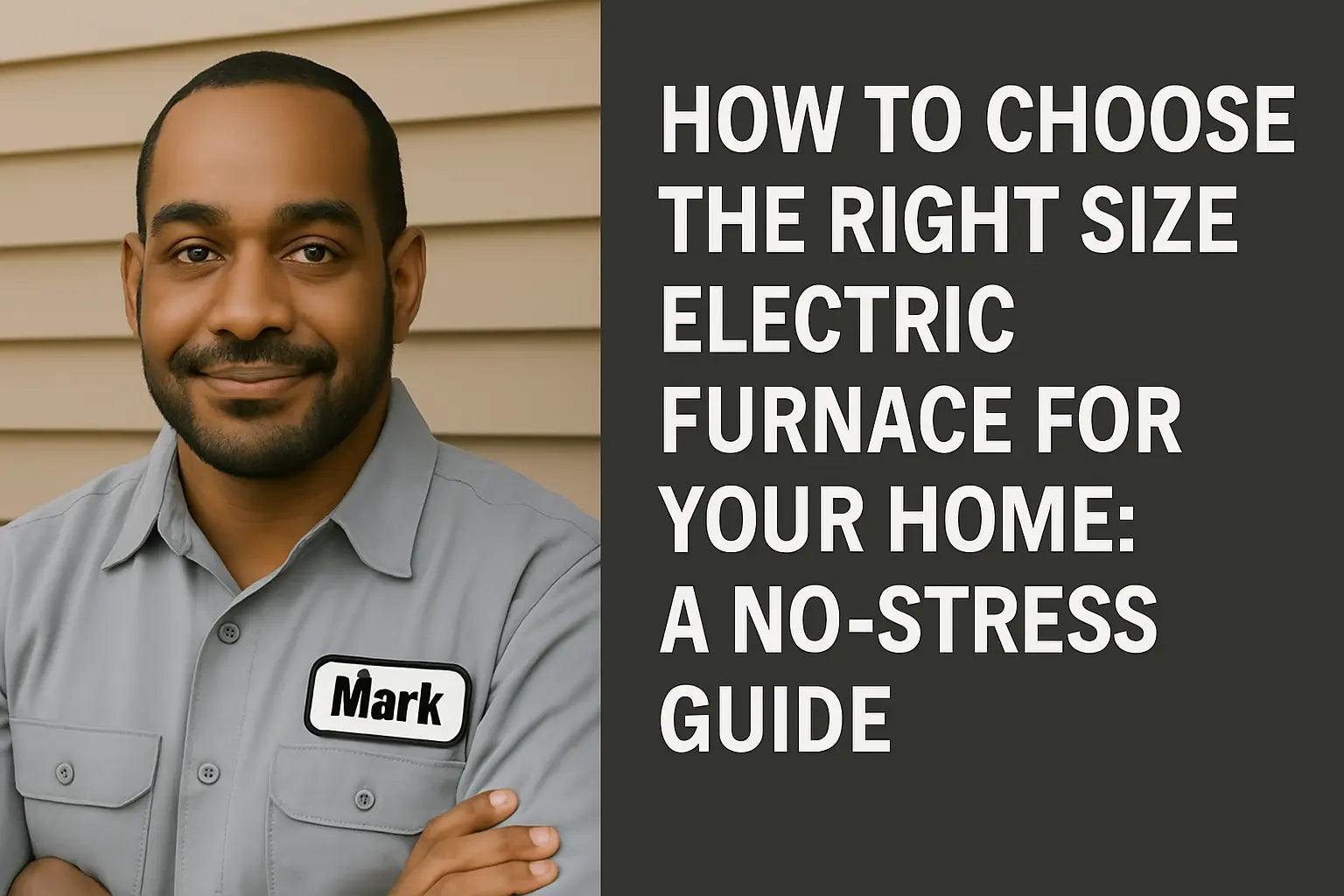Hey There, Mark Here 👋
You wouldn’t buy shoes two sizes too big, right? Same deal with your furnace. Sizing it right is everything—too small and you’ll freeze your toes off, too big and you’re wasting money and wearing it out early. In this post, I’m walking you through exactly how to size your electric furnace with zero guesswork, no advanced math, and no HVAC technician required (unless you want one).
Let’s get you warm the right way. 🔥
Why Furnace Sizing Matters (It’s Not Just About Heat)
Here’s the truth most big-box salespeople won’t tell you: oversized or undersized furnaces both suck.
If Your Furnace Is Too Small:
-
It will run constantly and still not heat the house
-
Your energy bills will spike 📈
-
The unit may overheat and shut down
If It’s Too Big:
-
It short-cycles (turns on/off too often), wearing out parts
-
Uneven heating: hot spots and cold zones
-
Moisture problems in winter (yep, really)
Getting it “just right” isn’t just about comfort—it’s about efficiency, safety, and long-term cost savings. As the U.S. Department of Energy says, proper sizing is critical to performance: Energy.gov HVAC Sizing Guide.
The BTU Basics: What Size Furnace Do I Need?
Electric furnaces are measured in BTUs—British Thermal Units. Think of a BTU as a little packet of heat. The more BTUs, the more heat your system can pump out.
So how many BTUs do you need?
A basic rule of thumb:
-
30–60 BTUs per square foot depending on climate and insulation.
| Home Size | Cold Climate | Moderate Climate | Warm Climate |
|---|---|---|---|
| 1,000 sq ft | 50,000–60,000 BTUs | 40,000–50,000 BTUs | 30,000–40,000 BTUs |
| 1,500 sq ft | 75,000–90,000 BTUs | 60,000–75,000 BTUs | 45,000–60,000 BTUs |
| 2,000 sq ft | 100,000–120,000 BTUs | 80,000–100,000 BTUs | 60,000–80,000 BTUs |
You can fine-tune this estimate using a free online HVAC Sizing Calculator. Super helpful if you're not into spreadsheets.
Key Factors That Impact Furnace Sizing
Let’s zoom in. Sizing isn’t just square footage—these real-world factors matter too:
1. Climate Zone
If you’re up in Minnesota or down in Texas, your needs are very different. The U.S. is divided into 5 climate zones, each affecting heating demand. Find your zone with this climate zone map from the IECC (scroll to Table R301.1).
2. Insulation
A well-insulated home needs fewer BTUs. Check attic, wall, and basement insulation. If your home’s older and hasn’t been updated, you may need to bump furnace size by 10–15%.
3. Ceiling Height
Higher ceilings = more air to heat. Add 10% more capacity for homes with vaulted ceilings or open-concept layouts.
4. Windows and Doors
Old, drafty windows? They leak heat like a sieve. If your house isn’t sealed tight, increase your BTU requirement slightly.
Electric Furnace Sizing Examples (With Real Math)
Let’s walk through some real-life scenarios:
🏡 1,200 sq ft Ranch Home in Ohio
-
Climate: Moderate
-
Insulation: Average
-
BTUs needed: 1,200 × 40 = 48,000 BTUs
-
Suggested system: A 15 kW electric furnace (roughly 51,000 BTUs)
🏠 2,000 sq ft Colonial in Massachusetts
-
Climate: Cold
-
Older insulation, tall ceilings
-
BTUs needed: 2,000 × 55 = 110,000 BTUs
-
Suggested system: A 30 kW electric furnace
Note: 1 kW ≈ 3,412 BTUs. So, divide total BTUs by 3,412 to convert to kilowatts. Pretty easy math—even for us tool guys. 😅
Avoiding Sizing Mistakes (Trust Me, I’ve Seen It All)
Here are the 3 biggest mistakes I see folks make when sizing an electric furnace:
1. Only Looking at Square Footage
Don’t skip windows, insulation, ceiling height, or ductwork condition.
2. Assuming Bigger Is Better
More power = more problems if your system cycles too often and burns out parts faster.
3. Skipping Professional Load Calculation
If you want the most accurate number possible, ask an HVAC pro to do a Manual J Load Calculation. This gold-standard method factors in all the things we’ve talked about. Learn more about it here from HVAC School.
How to Choose the Right Unit
Once you’ve done the math, the next step is picking a unit that matches. Here’s what I tell homeowners:
-
Choose an electric furnace that’s rated within 10% of your calculated BTU need
-
Make sure it works with your existing ductwork and voltage (usually 240V)
-
Consider models from The Furnace Outlet with modular designs that let you scale up or down
👉 Browse their lineup here: Electric Furnaces Collection
Bonus Tip: Pair With a Smart Thermostat 🧠
To get the most out of your properly sized furnace, pair it with a smart thermostat. I like the Nest Learning Thermostat, but Ecobee’s also great.
Smart thermostats:
-
Learn your patterns
-
Reduce energy waste
-
Keep temps consistent—no more cold spots
Wrapping It Up – Sizing Done Right 🎯
Sizing your electric furnace isn’t rocket science, but it’s also not something you want to wing. Get it right, and you’ll enjoy:
-
Lower energy bills 💸
-
Better comfort year-round
-
A longer-lasting system
Take the time, do the math, and don’t be afraid to ask questions. Or just reach out to the team at The Furnace Outlet—they’ve got your back.
Trying to decide between an electric or a gas furnace? Visit my guide: Let’s Break It Down.
Until next time, stay warm out there.
—Mark, your go-to HVAC tech







